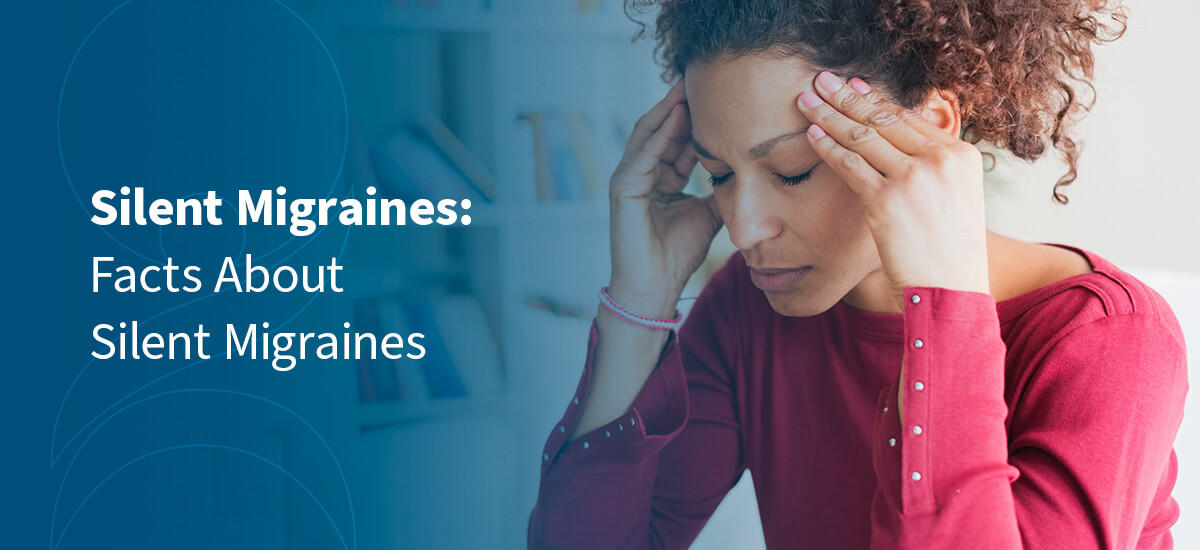Silent Migraines: Facts About Silent Migraines
While migraines can bring sharp, persistent pain, some people experience “silent migraines,” which do not involve headaches. Symptoms usually aren’t the same as regular migraines, like sensitivity to light and sound or one-sided head pain, though they can still be debilitating.
Silent migraines can significantly impact your daily life, often causing temporary vision loss, dizziness and confusion. Since they aren’t painful, an initial diagnosis can be challenging. Continue reading to learn more about symptoms, triggers and how to get silent migraine support if you or a loved one struggles with this condition.
Symptoms of Silent Migraine
Compared to classic migraine symptoms, most people with silent migraines are less likely to experience sensitivity to light, sound or odors during episodes. They also tend not to have one-sided head pain like traditional migraines. Even if head pain is not a factor, silent migraines can cause other symptoms that can interfere with your ability to do daily tasks. Symptoms can also recur or only appear once as an isolated event.
You might experience symptoms before the attack, which can arise within hours or the day before the migraine episode. These include:
- Feeling hyper or cranky
- Food cravings
- Fatigue and yawning
- Muscle stiffness, especially in the neck
- Frequent need to urinate
- Difficulty concentrating
- Trouble speaking or reading
- Diarrhea or constipation
Next, a silent migraine episode can include visual symptoms like seeing flashing lights, dots or wavy lines, tunnel vision and blind spots. You may also have trouble hearing, tasting or memory troubles. Silent migraines can also cause the following changes in your body:
- Weakness
- Stuffy or runny nose
- Numbness or tingliness in parts of the body
- Nausea or vomiting
- Confusion
- Chills and hot flashes
- Dizziness or vertigo
- Sore jaw or neck
- Sensitivity to light, smells, motion, touch or sounds
While migraine symptoms might last from four to 72 hours, silent migraine symptoms typically last only 15 to 30 minutes. Many people do not experience a silent migraine episode for longer than 60 minutes. After a silent migraine attack, you might feel sleepy and tired for up to a day. These symptoms often vary depending on the person and can be unpredictable.
What Triggers Silent Migraines?
While researchers have yet to pinpoint a cause of silent migraines, environmental and genetic factors likely play a role. People who get migraines may have abnormal genes that control specific cells in the brain. Unusual brain activity can affect blood vessels and nerves, causing inflammation and migraines.
Additionally, several factors can trigger a silent migraine attack.
- Specific foods: Foods and additives, such as salty and processed foods and aged cheese, might trigger silent migraines. Caffeine and alcohol can also increase the risk.
- Skipped meals and sleep problems: Skipping meals or sleep disturbances may also lead to silent migraine attacks.
- Physical strain: Overexerting yourself or straining your body can cause tension and migraines.
- External stimuli: Bright lights, loud sounds or strong smells like perfumes, paint or secondhand smoke can trigger migraines in some people.
- Use of some medications: Taking painkillers too often can cause headaches, as can hormonal medications like oral contraceptives.
- Stress: Stress in your professional or personal life can also lead to migraines.
While some triggers are unavoidable, learning your specific triggers can help you avoid them and prevent silent migraines. It also helps to understand migraine risk factors.
- Sex: Studies show women are more likely to experience migraines than men. Many people who experience migraines get them before or shortly after the onset of menstruation. Symptoms might also occur during menopause or pregnancy, generally subsiding after.
- Age: Migraines can occur at any age, though they commonly occur in adolescence, peaking during your 30s and becoming less severe in the following decades.
- Family history: Those with a family history of migraines have an increased risk of getting them too.
When to See a Doctor for Silent Migraine Treatment
Silent migraines often go undiagnosed and untreated, since they usually don’t come with telltale signs like persistent headaches. Even if you have a history of classic migraines, it helps to see a doctor to report changes if you suddenly feel different. You might also see a doctor or seek emergency services if you have severe signs or symptoms like:
- Fever or stiff neck
- Seizures
- Double vision
- Headache after a head injury
The above symptoms might indicate a more serious medical problem, such as a stroke. Health experts recommend tracking your symptoms, including how long they last and how you treat attacks. It also helps to keep a log of everything you eat and drink, changes in your sleep patterns, stress or other potential triggers. Then, make an appointment with your health provider, who can treat your condition with specific medications or therapies.
How to Prevent Silent Migraines
Silent migraines can significantly impact your daily life. Fortunately, you can try several things to prevent or manage your migraines, including:
- Identifying and avoiding triggers, if possible
- Massage therapy and other alternative therapies
- Practicing stress-relieving activities like mindfulness, meditation or yoga
- Regularly exercising while avoiding intense physical exertion
- Getting plenty of rest and going to bed at the same time each night
- Establishing regular, healthy meals
- Avoiding or limiting alcohol intake
- Cutting out caffeine
- Maintaining a healthy body weight
- Avoiding medications or switching to ones that do not trigger migraines
You might also see a chiropractor if you have a history of neck or head injuries. Unsurprisingly, people who suffer from migraines often experience migraine symptoms after these injuries. A chiropractor can provide silent migraine support to help treat or prevent further symptoms.
Contact UCC-NY for Migraine Support
Silent migraines can be debilitating. Fortunately, help is on your side. You may be a good candidate for chiropractic care if you’re experiencing severe headaches, migraines, neck pain or fatigue. Upper cervical chiropractic focuses on the bones and joints that support the head and neck. At UCC-NY, we use manual adjustments and other treatments to relieve migraine pain and improve function.
Our highly experienced health providers offer treatment for various conditions, including migraine headaches, neck pain, TMJ disorders, low back pain and headache treatment. For silent migraine support, contact us today to schedule an appointment.




